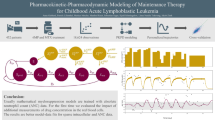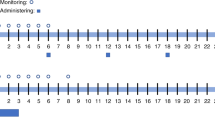Abstract
Busulfan pharmacokinetic parameters are useful in predicting the outcome of allogeneic bone marrow transplantation (BMT). Standard pharmacokinetic measurements require multiple blood samples. Various limited sampling models (LSM) have been proposed for reducing the sample number required for these measurements, essentially for patients with malignant disorders undergoing BMT. This study was undertaken to evaluate the existing LSM for busulfan pharmacokinetics to find out the most suitable method for patients with thalassaemia major undergoing BMT. Busulfan levels in plasma samples were analysed by HPLC. The AUC calculated by non-compartmental analysis using the program ‘TOPFIT’ was compared with previously published LSMs. Our seven sample pharmacokinetic data for AUC calculation was compared with the published LSMs. The three sample models suggested by Chattergoon et al and Schuler et al showed significant agreement with AUC TOPFIT (R2 = 0.98 and 0.94, respectively) in our clinical context. Other models resulted in significant over or under representation of observed values (Vassal's model R2 = 0.61; Chattergoon's two sample model R2 = 0.84; four sample model R2 = 0.83; Schuler's two sample model R2 = 0.79). By these data the three sample LSM proposed by Chattergoon et al and Schuler et al are suitable for calculation of the AUC in patients with thalassaemia major undergoing BMT conditioned with oral busulfan. Bone Marrow Transplantation (2001) 28, 821–825.
This is a preview of subscription content, access via your institution
Access options
Subscribe to this journal
Receive 12 print issues and online access
$259.00 per year
only $21.58 per issue
Buy this article
- Purchase on Springer Link
- Instant access to full article PDF
Prices may be subject to local taxes which are calculated during checkout


Similar content being viewed by others
References
Santos GW, Tutschka PJ, Brookmeyer R et al. Marrow transplantation for acute non-lymphocytic leukaemia after treatment with busulfan and cyclophosphamide New Engl J Med 1983 309: 1347–1353
Hobbs JR, Hugh Jones K, Shaw PJ et al. Engraftment rates related to busulfan/cyclophosphamide dosages for displacement marrow transplantation in 50 children Bone Marrow Transplant 1986 1: 201–208
Lucarelli G, Galimberti M, Polchi P et al. Bone marrow transplantation in patients with thalassemia New Engl J Med 1990 322: 417–421
Slattery JT, Sanders JE, Buckner CD et al. Graft rejection and toxicity following bone marrow transplantation in relation to busulfan pharmacokinetics Bone Marrow Transplant 1995 16: 31–42
Grochow LB, Jones RJ, Brundrett RB et al. Pharmacokinetics of busulfan: correlation with veno-occlusive disease in patients undergoing bone marrow transplantation Cancer Chemother Pharmacol 1989 25: 55–61
Regazzi MB, Locatelli F, Buggia I et al. Disposition of high dose busulfan in pediatric patients undergoing bone marrow transplantation Clin Pharmacol Ther 1993 54: 45–52
Vassal G, Fischer A, Challine D et al. Busulfan disposition below the age of three: alteration in children with lysosomal storage disease Blood 1993 82: 1030–1034
Gibbs JP, Gooley T, Corneau B et al. The impact of obesity and disease on busulfan oral clearance in adults Blood 1999 93: 4436–4440
Hassan M, Oberg G, Bekassy AN et al. Pharmacokinetics of high dose busulfan in relation to age and chronopharmacology Cancer Chemother Pharmacol 1989 28: 130–134
Vassal G, Challine D, Koscielny S et al. Chronopharmacology of high dose busulfan in children Cancer Res 1993 53: 1534–1537
Schuler U, Schroer S, Kuhnle A et al. Busulfan pharmacokinetics in bone marrow transplant patients: is therapeutic drug monitoring warranted? Bone Marrow Transplant 1994 14: 759–765
Hassan M, Oberg G, Bjorkholm M et al. Influence of prophylactic anticonvulsant therapy on high dose busulfan kinetics Cancer Chemother Pharmacol 1993 33: 181–186
Dix SP, Wingard JR, Mullins RE et al. Association of busulfan area under the curve with veno-occlusive disease following BMT Bone Marrow Transplant 1996 17: 225–230
Demirer T, Buckner CD, Appelbaum FR et al. Busulfan, cyclophosphamide and fractionated total body irradiation for allogeneic marrow transplantation in advanced acute and chronic myelogenous leukaemia: phase I dose escalation of busulfan based on targeted plasma levels Bone Marrow Transplant 1996 17: 341–346
Olivieri N . Thalassaemia: clinical management Baillières Clin Haematol 1998 11: 147–162
Richardson P, Guinan E . The pathology, diagnosis and treatment of hepatic veno-occlusive disease: current status and novel approaches Br J Haematol 1999 107: 485–493
Dennison D, Chandy M, Poonkuzhali B et al. Plasma busulfan levels influence rejection in bone marrow transplantation for homozygous beta thalassaemia Blood 1998 92: 127a
Poonkuzhali B, Srivastava A, Quernin MH et al. Pharmacokinetics of oral busulfan in children with thalassemia undergoing BMT Bone Marrow Transplant 1999 24: 5–11
Quernin MH, Poonkuzhali B, Medard Y et al. High performance liquid chromatographic method for quantification of busulfan in plasma after derivatization by tetrafluorothiophenol J Chromatogr 1999 721: 147–152
Heinzel G, Woloszezak R, Thoman P . Pharmacokinetic pharmacodynamic data analysis system for the PC Gustav Fischer: Stuttgart, Germany 1993
Chattergoon DS, Saunders EF, Klein J et al. An improved limited sampling method for individualized busulfan dosing in bone marrow transplantation in children Bone Marrow Transplant 1997 20: 347–354
Vassal G, Deroussent A, Challine D et al. Is 600 mg/m2 the appropriate dosage of busulfan in children undergoing bone marrow transplantation? Blood 1992 79: 2475–2479
Hassan M, Fasth A, Gerritsen B et al. Busulfan kinetics and limited sampling model in children with leukaemia and inherited disorders Bone Marrow Transplant 1996 18: 843–850
D'Argenio DZ, Schumitzky A . A program package for simulation and parameter estimation in pharmacokinetic systems Comp Prog Biomed 1979 9: 115–134
Acknowledgements
This study was supported in part by the Indo–French center for the promotion of advanced research (IFCPAR): project No. 2403–2. We also thank Ms Claudine Brunner for her help in preparing the manuscript.
Author information
Authors and Affiliations
Rights and permissions
About this article
Cite this article
Balasubramanian, P., Chandy, M., Krishnamoorthy, R. et al. Evaluation of existing limited sampling models for busulfan kinetics in children with beta thalassaemia major undergoing bone marrow transplantation. Bone Marrow Transplant 28, 821–825 (2001). https://doi.org/10.1038/sj.bmt.1703245
Received:
Accepted:
Published:
Issue Date:
DOI: https://doi.org/10.1038/sj.bmt.1703245
Keywords
This article is cited by
-
Comparison of Algorithms for Oral Busulphan Area Under the Concentration–Time Curve Limited Sampling Estimate
Clinical Drug Investigation (2014)
-
In children and adolescents, the pharmacodynamics of high-dose busulfan is dependent on the second alkylating agent used in the combined regimen (melphalan or thiotepa)
Bone Marrow Transplantation (2003)



